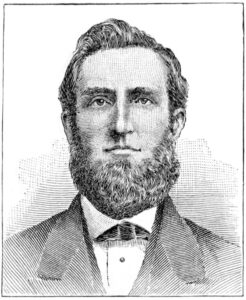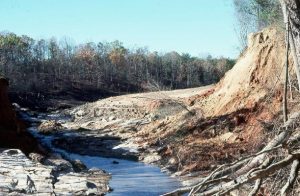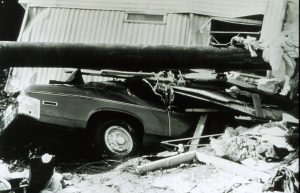atlanta

 During the Civil War, things like supply lines and lines of communication were crucial to both sides. The railroads became an important asset, as well as a liability, to both sides, depending on what they were carrying and where it was headed. On April 12, 1862, volunteers from the Union Army, led by civilian scout James J Andrews, commandeered a train called The General, and took it northward from Georgia toward Chattanooga, Tennessee. En route, they did as much damage as possible to the vital Western and Atlantic Railroad (W and A) line from Atlanta to Chattanooga. They were pursued for 87 miles by Confederate forces, trying at first to keep up on foot, and later resorting to a succession of locomotives, including The Texas.
During the Civil War, things like supply lines and lines of communication were crucial to both sides. The railroads became an important asset, as well as a liability, to both sides, depending on what they were carrying and where it was headed. On April 12, 1862, volunteers from the Union Army, led by civilian scout James J Andrews, commandeered a train called The General, and took it northward from Georgia toward Chattanooga, Tennessee. En route, they did as much damage as possible to the vital Western and Atlantic Railroad (W and A) line from Atlanta to Chattanooga. They were pursued for 87 miles by Confederate forces, trying at first to keep up on foot, and later resorting to a succession of locomotives, including The Texas.
Known as The Great Locomotive Chase, the military raid was also called the Andrews’ Raid or Mitchel Raid (after Major General Ormsby Mitchel, who had earlier assisted in the capture of Nashville and accepted the surrender of the city). In the end, as often happens in escapades like this, the raid made sensational headlines in newspapers, but it really had little impact on the war. It didn’t stop supply lines for the South or start new ones for the North.
In February, the Union soldiers captured Fort Henry and Fort Donelson, and Confederate General Albert Sidney Johnston knew he had to withdraw his forces from central Tennessee to reorganize. Johnston evacuated Nashville on February 23rd, and Nashville became the first Confederate state capital to fall to the Union. For Major General Don Carlos Buell, the taking of Nashville was enough, and on March 11th, Buell’s army was merged into the new Department of the Mississippi under General Henry Halleck. It was then that James J Andrews, a Kentucky-born civilian serving as a secret agent and scout in Tennessee approached Buell with a plan to take eight men to steal a train in Georgia and drive it north. Buell authorized the expedition in August 1863. Andrews, a train engineer in Atlanta, was willing to defect to the Union with his train, and without Andrews, taking over the train would have proved difficult. Getting onboard would have been easy enough, but running the train without experienced personnel is next to impossible. Since Andrews was willing to defect, he might also be able to supply a volunteer train crew to assist in running the train, tearing up track, and burning  bridges, so they would have an even greater chance of succeeding. The main target of the operation was the railway bridge at Bridgeport, Alabama, but Andrews had several other bridges in Georgia and Tennessee in mind too. Some of the men from Major General Mitchel’s division, encamped at Murfreesboro, Tennessee, were tapped to be the volunteers for this first raid.
bridges, so they would have an even greater chance of succeeding. The main target of the operation was the railway bridge at Bridgeport, Alabama, but Andrews had several other bridges in Georgia and Tennessee in mind too. Some of the men from Major General Mitchel’s division, encamped at Murfreesboro, Tennessee, were tapped to be the volunteers for this first raid.
The group of raiders moved south forty miles on foot to the Confederate railhead at Tullahoma. Then the caught a train to Marietta, Georgia. It was then that the operation hit its first snag, when Andrews discovered the engineer had been pressed into service elsewhere. Upon inquiring if any of the raiders knew how to operate a locomotive, they found that none did, and the raid was called off. Two raiders were also confronted by Confederate soldiers while trying to cut the telegraph lines, but successfully pretended to be overworked wiremen. Then the raiders returned north to Union lines, arriving about a week after they had departed. Andrews spent several days rearranging the operation and conducting reconnaissance on the Western and Atlantic Railroad before he headed north to federal lines too. The original raiders all refused to volunteer for the second raid, fearing the enemy. One said that “he felt all the time he was in the enemy’s country as though he had a rope around his neck.”
While the first raid was a bust, the second raid went off pretty well. The General was taken while the crew was a breakfast at the Lacey Hotel in Atlanta, and despite all the efforts to catch them, it arrived at milepost 116.3, north of Ringgold, Georgia, just 18 miles from Chattanooga and out of fuel. Andrews’s men abandoned The General and scattered. Andrews and all of his men were caught within two weeks. They even caught two volunteers who had the hijacking. Mitchel’s attack on Chattanooga was a failure.
All of the raiders were charged with “acts of unlawful belligerency.” The civilians among them were charged as unlawful combatants and spies. They were tried in military courts or courts-martial. Andrews was tried in 
 Chattanooga, found guilty, and hanged on June 7 in Atlanta. Seven others were transported to Knoxville and convicted as spies. They were returned to Atlanta and were hanged too. Their bodies were buried unceremoniously in an unmarked grave. Those bodies were later reburied in Chattanooga National Cemetery.
Chattanooga, found guilty, and hanged on June 7 in Atlanta. Seven others were transported to Knoxville and convicted as spies. They were returned to Atlanta and were hanged too. Their bodies were buried unceremoniously in an unmarked grave. Those bodies were later reburied in Chattanooga National Cemetery.

 My grandniece, Jala Satterwhite is having a great year. It is a year of firsts in many ways. A couple of weeks ago, she flew to Atlanta, Georgia…ALONE!! That in itself had her mom, Susan Griffith, in cringe mode. It was her first time, and that is a really big deal. The trip took Jala from Billings to Denver, and then to Atlanta. The Atlanta airport is one of the largest in the country, and Susan was really a nervous wreck. Jala met her boyfriend, Daylon Clarkson, in Atlanta, and then they spent a couple weeks at his aunt’s lake house in North Carolina. They had a wonderful time. Jala really hasn’t had a chance to travel so far from home alone, and she really enjoyed herself. She got to see lightning bugs and hear some frogs that sound like they must be huge in the evenings. The hummingbirds are huge there, and they look like a small airplane. The kids spent quite a bit of time on a boat there to. You just wouldn’t be at a lake house and not be on the water.
My grandniece, Jala Satterwhite is having a great year. It is a year of firsts in many ways. A couple of weeks ago, she flew to Atlanta, Georgia…ALONE!! That in itself had her mom, Susan Griffith, in cringe mode. It was her first time, and that is a really big deal. The trip took Jala from Billings to Denver, and then to Atlanta. The Atlanta airport is one of the largest in the country, and Susan was really a nervous wreck. Jala met her boyfriend, Daylon Clarkson, in Atlanta, and then they spent a couple weeks at his aunt’s lake house in North Carolina. They had a wonderful time. Jala really hasn’t had a chance to travel so far from home alone, and she really enjoyed herself. She got to see lightning bugs and hear some frogs that sound like they must be huge in the evenings. The hummingbirds are huge there, and they look like a small airplane. The kids spent quite a bit of time on a boat there to. You just wouldn’t be at a lake house and not be on the water.
When the time came, way too soon, to head for home, they drove Daylon’s truck back just about a week ago 
 with another one of their friends. They decided to drive straight through, taking turns driving and not stopping at all. Susan was really worried about that part, but these kids are adults now too, so they know the risks. One thing I’ve learned, after taking my own all-night drive with my granddaughter driving the whole way, is that these kids are night owls, and they can somehow get away with that. Nevertheless, I know how Susan feels too. It’s really hard to let your kids “spread their wings” but you have to do it. I think they left last Monday morning and rolled into town Tuesday evening around 7:00pm. it had to have been a really long two days. Pretty crazy kids! At least they made a few “sightseeing” stops on the way back. It gave them a chance to stretch their legs too. I’m sure that made the long drive easier and a lot more pleasant.
with another one of their friends. They decided to drive straight through, taking turns driving and not stopping at all. Susan was really worried about that part, but these kids are adults now too, so they know the risks. One thing I’ve learned, after taking my own all-night drive with my granddaughter driving the whole way, is that these kids are night owls, and they can somehow get away with that. Nevertheless, I know how Susan feels too. It’s really hard to let your kids “spread their wings” but you have to do it. I think they left last Monday morning and rolled into town Tuesday evening around 7:00pm. it had to have been a really long two days. Pretty crazy kids! At least they made a few “sightseeing” stops on the way back. It gave them a chance to stretch their legs too. I’m sure that made the long drive easier and a lot more pleasant.
Jala is still deciding if she wants to go to college or just learn as she works. Right now, she is working at a dog boarding kennel. She loves working with dogs and is pretty good at it. She seems to have a way with animals 
 of all kinds, although she hasn’t had a lot of time for her beloved horses this year. It’s difficult to fit in lots of time to ride and work full time too, but priorities have to change as life changes, and for Jala, it has been a year full of changes. At this point anyway, it looks like she will continue to live in Powell, which makes her mom very happy. Sometimes a trip away from home serves to make you realize just how much you love your home. Today is Jala’s 20th birthday. Happy birthday Jala!! Have a great day!! We love you!!
of all kinds, although she hasn’t had a lot of time for her beloved horses this year. It’s difficult to fit in lots of time to ride and work full time too, but priorities have to change as life changes, and for Jala, it has been a year full of changes. At this point anyway, it looks like she will continue to live in Powell, which makes her mom very happy. Sometimes a trip away from home serves to make you realize just how much you love your home. Today is Jala’s 20th birthday. Happy birthday Jala!! Have a great day!! We love you!!
 Probably because of the smaller cost of the materials and the ease of transporting material to the site, there are many earthen dams today. I suppose they were properly packed down, and with the addition of vegetation, they seem to hold up well…for the most part. The Toccoa Falls Dam (later known as the Kelly Barnes Dam) was constructed ninety miles north of Atlanta, Georgia. Toccoa is a Cherokee word meaning beautiful. The dam was built across a canyon in 1887, creating a 55-acre lake 180 feet above the Toccoa Creek.
Probably because of the smaller cost of the materials and the ease of transporting material to the site, there are many earthen dams today. I suppose they were properly packed down, and with the addition of vegetation, they seem to hold up well…for the most part. The Toccoa Falls Dam (later known as the Kelly Barnes Dam) was constructed ninety miles north of Atlanta, Georgia. Toccoa is a Cherokee word meaning beautiful. The dam was built across a canyon in 1887, creating a 55-acre lake 180 feet above the Toccoa Creek.
R A Forrest established the Christian and Missionary Alliance College along the creek below the dam in 1911. It is said that he bought the land for the campus from a banker with the only $10 dollars he had to his name, offering God’s word that he would pay the remaining $24,990 of the purchase price later. I guess that the banker either trusted Forrest’s ability to pay the  balance, or decided that a Christian college would a good gift to give, whether Forrest was ever able to pay it off or not.
balance, or decided that a Christian college would a good gift to give, whether Forrest was ever able to pay it off or not.
The Christian and Missionary Alliance College had been on the site for 66 years in 1977. On November 5, 1977, a volunteer fireman inspected the dam and found everything in order. A few hours later, in the early morning of November 6, the dam suddenly gave way. With a great roar, water thundered down the canyon and creek, approaching speeds of 120 miles per hour. Still, the residents of the college had no time to evacuate. Within minutes, the entire community was slammed by a wave of water. One woman, a mother of three daughters, managed to hang onto a roof torn from a building. The wave carried her for thousands of feet. She survived, but her three daughters, were among the 39 people who lost their lives in the flood.

The investigation that followed, cited several possible or probable causes for the disaster. The failure of the dam’s slope may have contributed to weakness in the structure, particularly in the heavy rain of the previous four days. The rain swelled Barnes Lake, which normally held 17,859,600 cubic feet of water, to an estimated 27,442,800 cubic feet of water. When the low-level spillway collapsed, it exacerbated the problem. A 1973 photo showed a 12 foot high, 30 foot wide slide had occurred on the downstream face of the dam, which may have also contributed or foreshadowed the dam failure. Basically, the dam was in poor condition and the design was poor and outdated. It was a disaster waiting to happen.

